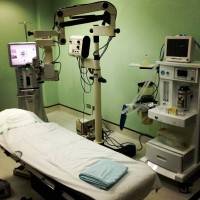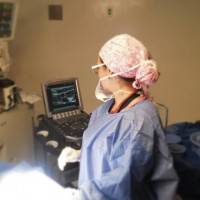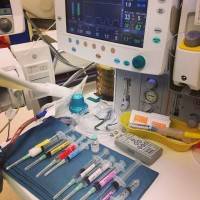Can Rhinoplasty Be Done Under Local Anesthesia?
The choice of which type of anesthesia to use during rhinoplasty surgery depends on several factors. A very minor rasping can be done under local anesthesia.
The majority of rhinoplasty procedures, in my experience, are more involved and require deeper anesthesia. This allows the anesthesia provider to keep you very comfortable for the whole procedure.
This would mean either IV sedation or general anesthesia with a breathing tube used to protect your airway. As you can see from the others’ responses, there is a wide range in surgeon preferences.
You, as the patient, can have input as well so certainly discuss your options with your surgeon. (Thomas A. Lamperti, MD, Seattle Facial Plastic Surgeon)
Sedation (“twilight”) or general anesthesia are most commonly used for rhinoplasty
In my experience, so called “twilight” anesthesia or monitored-anesthesia (MAC) are sufficient for all rhinoplasty cases.
However, this requires an anesthesiologist that is comfortable with deep sedation and a surgeon that can perform meticulous local anesthesia.
Both are required for a smooth, consistent plane of anesthesia. At present, the majority of rhinoplasty surgeons are using general anesthesia but an experienced surgeon with an experienced anesthesiologist or CRNA can effectively perform rhinoplasty under sedation which results in quick recovery and less post-operative nausea, in most cases. (Stephen Weber, MD, FACS, Denver Facial Plastic Surgeon)
Most rhinoplasties are performed under general anesthesia. A very minor adjustment in nasal contour or projection can be done under local anesthesia, but this is often a source of anxiety for the doctor and the patient (because the patient is awake for the procedure). Some practitioners perform sedation or “twilight anesthesia.”
This is IV medication and local anesthesia. The safer option is either general anesthesia or local, because sedation involves an unprotected airway (no intubation). The thought of general anesthesia is frightening for many, but it is the standard for rhinoplasty procedures and is a safe option. (Jason R. Hess, MD, San Diego Plastic Surgeon)
Rhinoplasty is performed under general anesthesia…
General anesthesia is best for rhinoplasty because the airway is protected and the patient will not be aware of anything happening during the procedure. A healthy patient will do very well with anesthesia and patient comfort is always a priority for us. (Andrew Miller, MD, Edison Facial Plastic Surgeon)
It really depends on your surgeon and their preference. It can be either a General or it can be done with IV sedation. My preference is to use IV sedation and this has worked well for over 20 years for me.
If someone requires significant internal nasal work (breathing problems) then I will use a general anesthetic. I believe the use of either type of anesthesia is acceptable and it will be something your surgeon will discuss with you. (Scott R. Brundage, MD, Grand Rapids Plastic Surgeon)
The best anesthesia is a function of surgeon and anesthesiologist
Anesthesia can vary dramatically from surgeon to surgeon. Each surgeon has certain likes and dislikes. Rhinoplasty is usually done under deep IV sedation or general anesthesia. The key points are as follows. The case should be done at an accredited surgery center with a board-certified anesthesiologist. The complexity and estimated length of the case also contribute to the type of anesthesia chosen. (Raghu Athre, MD, Houston Facial Plastic Surgeon)
Rhinoplasty surgery generally requires IV sedation.
Rhinoplasty should be performed in an accredited surgery center and is typically performed under IV sedation (twilight anesthesia). While some Doctor’s may use general anesthesia where the patient requires intubation (placing a breathing tube through the vocal cords so a machine can breathe for the patient,) we prefer not to intubate our patients.
This allows for more comfort during the postoperative period as patients are less likely to become nauseated or vomit which can lead to bleeding. (Jon E. Mendelsohn, MD, Cincinnati Facial Plastic Surgeon)
Rhinoplasty anesthetic tailored to your choice
Rhinoplasty can be done under a general anesthetic (with intubation) or under a sedation / twilight. Most surgeons have a preference toward one or the other but should listen to YOUR preference.
I personally use sedation because I see a faster recovery with less nausea, and patients still remember nothing. If you have a preference, be sure to discuss this with your surgeon! (Catherine Winslow, MD, Indianapolis Facial Plastic Surgeon)
Anesthesia for rhinoplasty – nose job
Rhinoplasty anesthesia is based on surgeon preference. However, the majority of rhinoplasties are done under general anesthesia. This is important not only for sedation and pain control, but also to protect the airway. (Etai Funk, MD, Houston Facial Plastic Surgeon)
Choice of Anesthesia
Rhinoplasty, is one of a few operations for the choice of anesthesia really depends upon the preference of the patient, and the surgeon’s concept of safety and what will be best for the patient. Very few surgeons choose to do the procedure under local anesthesia, although it is technically possible. Prefer your choice of deep sedation, or general anesthesia.
The advantage of a general anesthesia is that in the airway is in place preventing your loss of airway, and a serious complication. It is best to discuss these options with your surgeon at the time of consultation. (John E. Sherman, MD, New York Plastic Surgeon)
Types of anesthesia for nose job (rhinoplasty)
The anestheisa requirements for rhinoplasty (nose job) depend on the extent of the procedure and the surgeon’s preference.
A relatively minor tip rhinoplasty can easily be performed under local or IV sedation or monitored anesthesia care.
However, an open rhinoplasty with rib grafts is best done, in my opinion, under general anesthesia. (Otto Joseph Placik, MD, Chicago Plastic Surgeon)
Type of anesthesia with Rhinoplasty
Rhinoplasty should be performed with either a) IV (deep) sedation or b) general anesthesia
IV sedation rhinoplasty anesthesia: this type of anesthesia is performed by administering medications through an IV. From a patient’s standpoint you will be asleep and unaware of your surroundings. No endotracheal tube (for breathing) is used because you are breathing on your own during the entire procedure. This technique is not appropriate for all patients (eg.people with sleep apnea) because the airway may be too floppy once the relaxation medications kick in, making difficult for them to breathe.
General rhinoplasty anesthesia: this type of anesthesia is performed with the use of an endotracheal tube (for breathing). From a patient’s standpoint you will be also be asleep and unaware of your surroundings just like IV sedation. Although you experience the same thing, general anesthesia is a ‘deeper’ form of anesthesia that allows for much more invasive procedures to be done.
This type of anesthesia is used for procedures like abdominal surgery or chest surgery. It is a safer choice if you have airway concerns that make it inappropriate to use IV sedation.
Bottom line: There is really no right or wrong, assuming you are eligible for either. In the appropriate candidate, both are safe methods for rhinoplasty.
Most surgeons have a preference dictated by what they are used to using, or by what their operating facility/anesthetist/anesthesiologist offers. (Lawrence Tong, MD, Toronto Plastic Surgeon)
Rhinoplasty anesthesia
Rhinoplasty is often done under sedation, or twilight anesthesia, or general anesthesia. It really depends on how much modification your nose would need.
I would focus your efforts on finding the right surgeon, and then discuss with him how he/she can give you the best result with which anesthetic technique. This will prove much more important!
The revision rhinoplasty patients we see in Michigan often state that they wished they would have picked a surgeon who specialized in nasal surgery instead of focusing on to whom their friends had gone for breast surgery or liposuction. (Pramit Malhotra, MD, Ann Arbor Plastic Surgeon)
Anesthesia for rhinoplasty
Either deep sedation or general anesthesia. The latter is my constant preference because the patient remains well ventilated under control of the anesthesiologist, throat packing can be used to prevent swallowing of blood with related emesis, hematemesis, coughing, and/or gagging, there is no movement during this delicate procedure so surgeon maintains better control over the result, and the patient truly has no sensation or recollection of osteotomies and other deep (septal) surgical manoeuvres. (Steve Laverson, MD, San Diego Plastic Surgeon)


